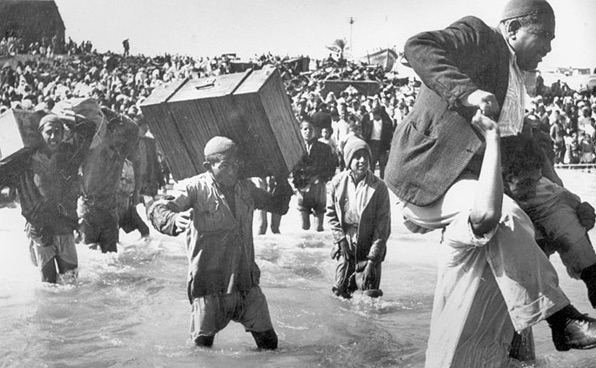The AP reported earlier today that,
The Trump administration is preparing to withhold tens of millions of dollars from the U.N. agency for Palestinian refugees, cutting the year’s first contribution by more than half or perhaps entirely, and making additional donations contingent on major changes to the organization, according to U.S. officials.
The United States’ annual contribution to the UN agency in question, UNRWA came to $380 million in 2015 (PDF here), that is, 33.9% of UNRWA’s total spending of $1.12 billion. The United States also contributes a roughly similar amount– per this December 2016 CRS report, PDF, p.3– to support the Ramallah-based Palestinian Authority (PA.)
Of those two sums, the contribution to UNRWA helps to support 5.26 million registered Palestinian refugees currently residing in Lebanon, Syria, Jordan, the West Bank and Gaza. Nearly all these people are Palestinians who were expelled in 1947-48 from their homes in what became Israel in 1948, though a small number are refugees who fled the West Bank for Jordan in 1967. (The photo at the head of this blog post comes from the UNRWA archives. It shows Palestinians fleeing from Jaffa or Haifa in 1948– in scenes eerily similar to the scenes of Rohingya families fleeing Myanmar over these recent months.)
More data about the distribution and location of the registered refugees can be found here. It should be noted that “registered” Palestinians refugees form only a small proportion– probably less than half– of the total number of the Palestinian refugees/exiles who still have an outstanding claim to return to homes, properties, and full citizenship status inside 1948 Israel.
The United States’ annual contribution to the PA is an outgrowth of the 1993 Oslo Accords, which set up the PA as an interim self-governing authority, pending the conclusion of a final peace treaty between Israel and the PLO, which was supposed to happen by 1999. This contribution helps to fund the operations of the PA in the West Bank, which has a population of roughly 3.0 million (including in occupied East Jerusalem), and also to pay the salaries of some currently-furloughed PA staff in Gaza, population 2.0 million.
Roughly 2/3 of Gaza’s people and 40% of the West Bank’s people are actually registered refugees and thus receive services from UNRWA: so there is some overlap between the work of UNRWA and that of the PA. However, roughly half of UNRWA’s beneficiaries live outside the area controlled by Israel. The UNRWA-served refugee populations in Jordan, Lebanon, and Syria have all suffered greatly over the years, so the organization is constantly on a crisis footing.
The missions of UNRWA and of the PA are very different. It should also be noted that threats to reduce or end U.S. funding “to the Palestinians” in general, whether to UNRWA or the PA, are a long-time staple of Zionist political rhetoric in the United States and among AIPAC’s key allies in Congress and the media.
UNRWA was established in 1950– before the establishment of the UN’s broader, worldwide refugee agency, the UN High Commission for Refugees. The two bodies have never merged, and there are some differences in their mandates. However, both agencies place stress on the idea that repatriation of refugees to their original homelands once peace is restored is the best and preferred ultimate outcome for refugees. This key fact too often gets lost in discussion of refugee issues in general, inside the United States, a country in which (for historical reasons) transcontinental migration is often seen as, really, quite “normal”… almost part of the natural order of things.
UNRWA’s mandate of providing “relief and works” for the Palestine refugees, but not their resettlement, grew directly out of the provision of the UN’s Resolution 194 of December 11, 1948 passed in the wake of the Arab-Israeli war of that year. In Article 11 of resolution 194 the gathered nations of the world resolved that: “the refugees wishing to return to their homes and live at peace with their neighbors should be permitted to do so at the earliest practicable date… ” UNRWA’s mandate (like that, much later, of the PA) was also thus planned to be short-term and provisional, pending conclusion of the peace between the parties to the fighting of 1947-48 which would allow the peaceable return of the refugees to their original homes.
Just one day before the UN General Assembly adopted Resolution 194, it had also adopted the “Universal Declaration of Human Rights”, Article 13, clause 2 of which states: “Everyone has the right to leave any country, including his own, and to return to his country.”
For the Zionists, in Israel and worldwide, the Palestinians’ “Right of Return” has always been anathema. Thus, they have long favored the resettlement of Palestinian refugees in other countries over the idea that most, some (or even any) of these refugees might be repatriated to their own families’ ancestral homes and properties. It’s also worth noting that, just as with babies born to Rohingya refugees in Bangladesh today, or babies born to Syrian refugees in Jordan: such babies all inherit the civil status of their parents. So now, in the refugee camps established for Palestinian refugees back in 1949 or 1950, some of the babies being born today are the fourth or fifth generation of refugees in their families, but they still have the same civil status and all the same rights as the original refugees.
Most Zionists would love to dissolve UNRWA, and along with it all the claims that the Palestinian refugees have on homes, properties, and political rights within 1948 Israel. But the international community as a whole has continued since 1950 to express solid support for the humanitarian-aid work done by UNRWA and a great degree of rhetorical support for Resolution 194. But no group of countries has ever been able to persuade Israel to implement Resolution 194 (or any of the peace-mandating and occupation-ending resolutions that the Security Council passed in and after 1967…)
Some Zionists would also be happy to dissolve the PA as well, though there is a strong degree of understanding among most supporters of Israel’s current, strongly Zionist government that the PA serves the Israeli government’s purposes very well. To see why, it is necessary only to look at the situation in the days before the Oslo agreement, when all the financial and manpower costs of running the Israeli occupation of the West Bank and Gaza were borne directly by the Israeli government itself.
As U.S. citizens came to learn (or to be reminded) in Iraq in 2003, running a military occupation of a foreign country can be a very expensive undertaking– and it becomes even more expensive if “the natives” get rebellious and start withdrawing their cooperation from the occupiers, or start engaging in either the nonviolent mass civil disobedience or the armed resistance struggle that it is their right to wage under international law.
In the case of Israel’s 50-year-plus occupation of the West Bank and Gaza, the establishment of the PA in 1994 meant that nearly all the direct costs of running the occupation were immediately handed over to the PA; and since the PA has never had any ability to bear those costs, they have been borne instead by international donors– primarily the United States, the EU, and Japan. Thus, governments which would never (in most cases) have consented to finance Israel’s direct administration of the occupation have found themselves for the past 23 years bearing the cost of supporting the PA’s continued administration of the occupation.
From Israel’s perspective, this means that– at the financial level– the occupation can go on indefinitely. Contrast that with the situation prior to the Oslo Accords, when the costs that Israel had to bear related to its maintenance of the occupation and its suppression of the overwhelmingly nonviolent First Intifada were widely discussed in Israel (by Peace Now) as providing strong incentives for Israel to end the occupation.
No such financial incentive exists today. Indeed, there has been some significant research into the extent to which Israeli governmental and private entities have been able to make a profit off the occupation— both through the tariffs and other fees that aid organizations have been forced to pay to get their materials into the occupied areas, and in terms of the profits that Israeli companies have been able to make through supplying materials and services to the aid organizations. Added to which, the residents of the occupied territories have continued to be a total captive market for Israeli products across the board.
Maintaining the PA in place can thus be seen as a good way for Israel’s supporters around the world to continue to serve the interests of Israel’s current government– though every so often, staunch Zionist supporters in Washington DC like to threaten a reduction in aid to the PA, mainly as a way to keep the PA marching to their tune.
Defunding UNRWA, by contrast, is something that many Zionist supporters around the world have long sought to do.
Pres. Trump’s current threat to cut or end UNRWA’s funding needs to be taken seriously. However, there are plenty of other governments around the world that could pick up the funding slack, even if he were to eradicate the US’s aid to UNRWA completely. UNRWA, as an international organization, does not have to bend to his will. And if he does end up reducing or cutting US aid to UNRWA, then this will be yet another marker of Washington’s reduction of its role in the Middle East.

